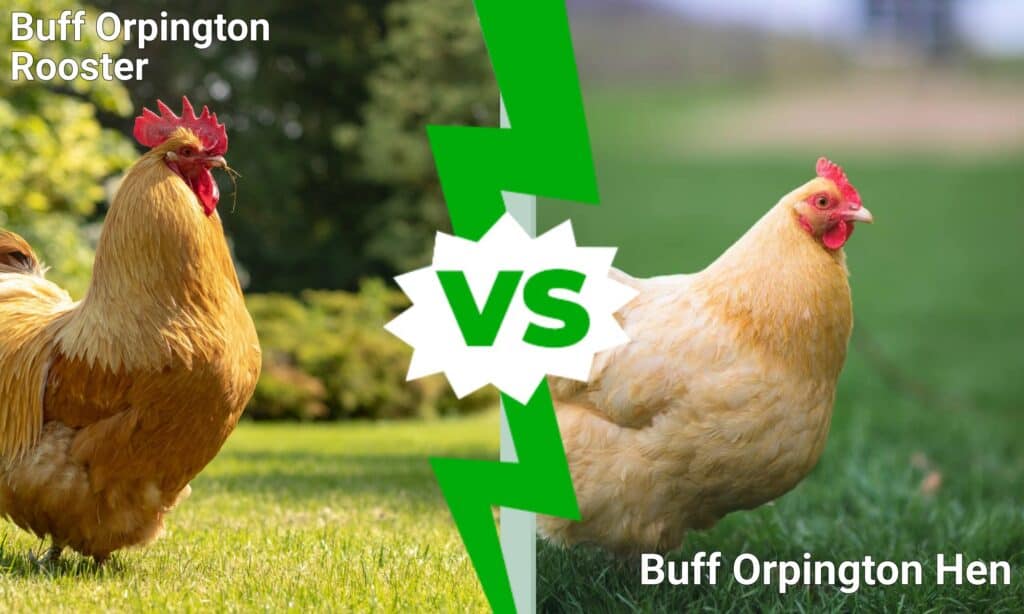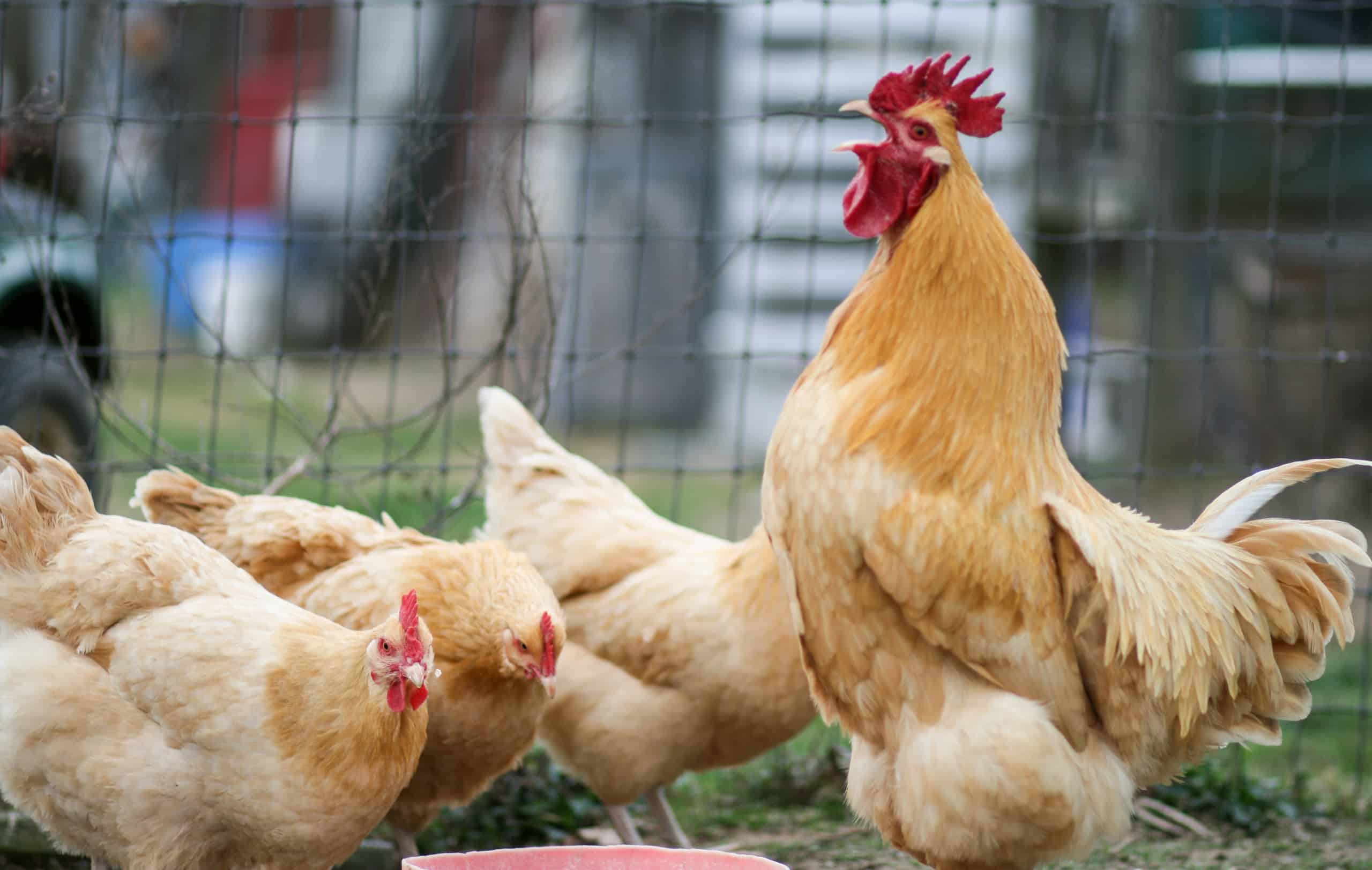Buff Orpington Hen Vs. Rooster: How to Tell Them Apart Easily?
Buff Orpington hens are known for their egg-laying abilities and docile nature, while roosters are recognized for their protective instincts and crowing. Hens typically weigh around 7-8 pounds, whereas roosters can reach up to 10 pounds.
Buff Orpingtons are a popular breed among chicken enthusiasts. Their friendly demeanor makes them ideal for families and small farms. Hens are prolific layers, producing brown eggs regularly. Roosters contribute to flock protection and can be quite vocal, signaling the start of the day with their crowing.
Both sexes display beautiful golden feathers, but their roles within the flock differ significantly. In this post, you learn about Buff Orpington Hen Vs. Rooster.
What is buff orpington chicken?

Credit: grubblyfarms.com
The Buff Orpington breed has a rich history. It originated in England during the 19th century. Farmers wanted a bird that was beautiful and useful.
Buff Orpingtons became popular for their friendly nature and good egg production. They lay large, brown eggs regularly. This breed is also known for its calm and gentle temperament.
Many backyard poultry enthusiasts choose Buff Orpingtons. Their stunning golden feathers attract attention. These birds adapt well to various climates and conditions.
Overall, Buff Orpingtons are a great choice for families and hobbyists.
Buff Orpington Hen Vs. Rooster

Credit: a-z-animals.com
Physical Characteristics
The Buff Orpington breed has distinct physical traits. Hens and roosters share a similar overall shape. Their bodies are round and robust, making them look strong and healthy.
Feather coloring is one of their standout features. Hens and roosters have a golden-buff color. The feathers are soft and smooth, providing excellent insulation.
The texture varies slightly between the sexes. Hens possess a fluffier appearance due to more feathers. Roosters have longer feathers, especially on their necks and tails.
This breed is known for its gentle demeanor. Buff Orpingtons are friendly and easy to handle. Their calm nature makes them great pets.
Buff Orpington Chicken Behavioral Traits
Buff Orpington hens and roosters exhibit different behavioral traits. Hens are usually more docile and friendly. They often form strong bonds with their flock. Roosters can be more assertive and protective. They often establish a social hierarchy within the flock.
The social structure includes a dominant rooster and several hens. Roosters may engage in displays of dominance to maintain their position. Hens often follow the rooster and seek his protection. This dynamic helps ensure safety from predators and other threats.
Temperament differences are notable. Hens tend to be calmer, while roosters can be more vocal and active. Understanding these traits helps in managing their behavior effectively.
Sexual Dimorphism of Buff Orpington Chicken

Credit: a-z-animals.com
The Buff Orpington hen and rooster show clear differences. Hens are generally smaller than roosters. A hen can weigh around 6 to 8 pounds. In contrast, a rooster typically weighs 8 to 10 pounds. This size difference is noticeable at a young age.
Comb and wattle development also varies between genders. Hens have smaller combs and wattles. Roosters develop larger, more prominent combs. The comb helps with temperature regulation. A well-developed wattle indicates a healthy rooster.
Vocalizations And Sound Patterns
The crow of a rooster is loud and distinctive. It serves to mark territory and attract hens. Roosters typically crow at dawn but can crow at any time. Their vocalizations can vary in pitch and length.
Hens communicate through clucking sounds. Clucking is often soft and can signal comfort or alertness. Hens also uses different sounds for various messages. These vocalizations help maintain social bonds within the flock.
Reproductive Roles
Buff Orpington hens are known for their excellent egg-laying capacity. They can produce up to 200-280 eggs per year. These eggs are typically large and brown, making them popular among farmers.
Roosters play a crucial role in fertility. They are responsible for fertilizing the eggs laid by hens. A single rooster can mate with multiple hens. This ensures a higher chance of fertile eggs in the flock.
Healthy roosters help maintain a balanced breeding environment. They contribute to the overall health and productivity of the flock. Choosing the right rooster is essential for successful breeding.
Care And Management for Buff Orpington Chicken
The Nutritional Needs of Buff Orpingtons include a balanced diet. They thrive on high-quality feed rich in protein and vitamins. Fresh fruits and vegetables can enhance their health. Clean, fresh water must always be available. Calcium supplements are essential for laying hens.
Housing Requirements are crucial for Buff Orpingtons. They need a spacious coop with good ventilation. A safe, dry area protects them from predators. Clean bedding, like straw or wood shavings, is important. Ensure enough space for each bird to roam comfortably.
| Nutritional Needs | Housing Requirements |
|---|---|
| High-quality feed | Spacious coop |
| Fresh fruits and vegetables | Good ventilation |
| Clean, fresh water | Safe, dry area |
| Calcium supplements | Clean bedding |
Conclusion
Buff Orpington hens and roosters belong to the same breed but differ in their role and characteristics. Generally, hens are quiet, friendly, and laid-back, since it is their concern to lay eggs, having a very calm disposition and being very docile. They usually weigh 6 to 8 pounds and can lay large brown eggs. Roosters are more aggressive and sometimes become protectors of the flock. They are brighter in plumage and usually heavier; the weight reaches 8-10 pounds. Besides, roosters have a crow for each signal: the start of a new day or warning by showing their bright presence in the yard.
Happy farming!
FAQs About Buff Orpington Chicken
Buff Orpingtons are very good layers, normally laying between 200-280 large brown eggs in a year. Most of them will continuously lay, even in the cooler weather. These birds have personalities that are calm and quite hardy, so they are one of the most popular breeds when people consider backyard flocks. They will continue laying into their second or even third year with the right care. The Buff Orpingtons are reliable and rewarding birds in terms of laying eggs.
Buff Orpingtons get their name because of their distinct color and origin. “Buff” refers to their golden, yellow-brown feathers. “Orpington” comes from the town of Orpington in Kent, England, where the breed was developed. The combination of these two traits led to the name, which reflects both their appearance and the place they were first bred. These chickens are known for being friendly and hardy.
The general demeanor of Buff Orpington chickens is calm and friendly. These birds have been known to be very gentle by nature, making them awesome for families and small farms. These birds are not known to be aggressive and mostly cohabit peacefully with other chickens. Their disposition makes them easy to manage and look after; thus, they are a favorite of many backyard poultry fanciers.
Buff Orpingtons grow at a medium rate. They do not grow as fast as some other breeds but are very consistent in their growth. On average, they take six to eight months to reach their full size. Their growth rate is based on feed, health, and space. They are found to be very healthy and grow well when they are fed well and given enough space. They may be a bit behind in maturity compared to others.







